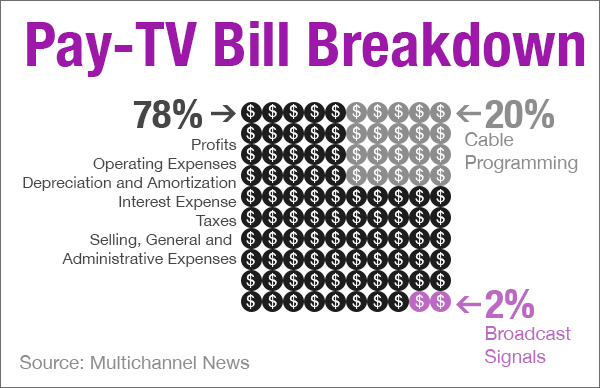The debate over ‘reform’ in the U.S. video marketplace is intensifying in Washington, D.C., with the House Subcommittee on Communications and Technology beginning the legislative process as part of a hearing last week and the Senate Judiciary Committee expected to hold its own hearing on the reauthorization of the Satellite Television Extension and Localism Act (STELA) on March 26th.
If pay-TV is granted its ‘wish-list’ of regulatory add-ons as part of the STELA reauthorization process, it would ultimately tilt the regulatory playing field in their favor over TV broadcasters in retransmission consent negotiations.
Pay-TV Motives for Marketplace Advantage?
Pay-TV operators are seeking to box in America’s TV broadcasters on retransmission consent negotiations in an effort to lower the fees they pay for broadcast-TV programming so they can then find new ways to force consumers to pay more for cable programming. The likelihood of consumers’ monthly pay-TV bills going down if pay-TV wins this legislative push is virtually nil. After all, when have consumers ever really seen their cable or satellite TV bills go down?
The increased prices for cable content may come in the form of expanded basic tier or premier bundled programming packages; or by adding mandatory fees to the monthly bill that all customers would be forced to pay for regional sports networks (i.e. Time Warner Cable’s deal with the Dodgers to air regular-season baseball games on SportsNet LA).
Pay-TV operators are driving the push for legislative add-ons and are fiercely arguing that there is a need for these changes in the name of the public interest, competition and consumer harms. However, the incidents of service disruptions caused by retransmission consents disputes involve less than one percent of all cases negotiated annually.
In fact, hundreds of retransmission consent deals are agreed to each year through free-market negotiations with no impact on pay-TV viewers. The reality is that there is a higher chance of consumers losing their cable or satellite TV service because of a moderate snowstorm than as a result of a retransmission consent dispute.
What’s Really Increasing Monthly Pay-TV Bills?
Are retransmission fees for broadcast TV increasing? Yes, but the cost to pay-TV viewers is approximately 9.4% of their programming costs, or just under $5 per month for access to popular broadcast-TV programming, as well as local news, weather reports and emergency alerts and warnings.
In a video marketplace in which less popular cable channels, with significantly lower viewership ratings, are being compensated two to three times more than TV broadcasters for the most-watched channels, it’s disingenuous to blame the cost of broadcast TV programming for consumers’ rising cable and satellite TV bills.
In 2013, cable channels were compensated more than $32 billion by cable and satellite TV operators, while TV broadcasters received a collective total of $3.3 billion for their popular and most-watched news, entertainment and sports programming. The bottom line is that cable channels are compensated nearly 10 times more than TV broadcasters for video content, despite much lower ratings.
Unfortunately, many pay-TV providers are breaking out the cost of broadcast TV programming on consumers’ monthly bills when more than 90% of programming charges are generated by the costs for cable channels.
These cable-generated programming costs significantly add to consumers’ rising pay-TV bills, along with extra fees for set-top boxes and DVRs, one-time ‘change-of-service’ charges and punitive early-termination fees.
According to the NPD group, consumers today are paying, on average, approximately $86 per month for pay-TV service, with expected increases to $123 per month by 2015 and to $200 per month by 2020, if current market trends continue (calculated at a 6% annual increase).
Even-Handed Legislative Review of the Regulatory Landscape?
During last week’s House hearing on the reauthorization of STELA, Marci Burdick, Senior VP of Broadcasting, Schurz Communications, Inc., said “If there are going to be requirements that govern how one side of the table (broadcasters) can negotiate retransmission consent, then similar agreements on the multichannel video programming distributor (pay-TV) side should also be looked at (too).”
Since hundreds of deals are reached each year without disruption for America’s pay-TV viewers, why the urgency to give cable and satellite TV providers the upper-hand in negotiations?
Some lawmakers have suggested that any regulatory changes in the marketplace should be undertaken as part of a comprehensive update of the 1996 Telecommunications Act to better reflect the rapid convergence of technology over multiple platforms for the delivery of video services to consumers. We whole-heartedly agree.
This legislative process will also provide lawmakers with an opportunity to ask the tough questions of cable and satellite TV operators about what is truly causing consumers’ monthly bills to increase year after year.
Will Pay-TV or Consumer Interests Prevail?
The question is still out on how these legislative add-ons, if signed into law, will benefit consumers and lower their monthly cable and satellite-TV bills.
Ironically, pay-TV may be its own worst enemy by battling broadcasters on the legislative and regulatory fronts. What will the excuse be to consumers if pay-TV operators get the legislative add-ons and lopsided policy changes they are seeking on retransmission consent and no longer have the luxury of blaming broadcast TV for rising monthly bills?
Ultimately, more and more consumers may seek to switch to other competitors for their TV service or cut the cord all together and go to free, over-the-air broadcast TV.
Let’s hope regulatory overreach by lawmakers and policymakers doesn’t force some local broadcast TV stations off the air, leaving pay-TV customers with less choices for local news coverage, while also absorbing excessively high and continually rising monthly cable or satellite TV bills with no relief in sight.
Is there something wrong with this picture?
Robert C Kenny is the Director of Public Affairs for TVfreedom.org, a coalition of local broadcasters, community advocates, network TV affiliate associations, and other independent organizations; he formerly served as Press Secretary at the FCC.
Read More


